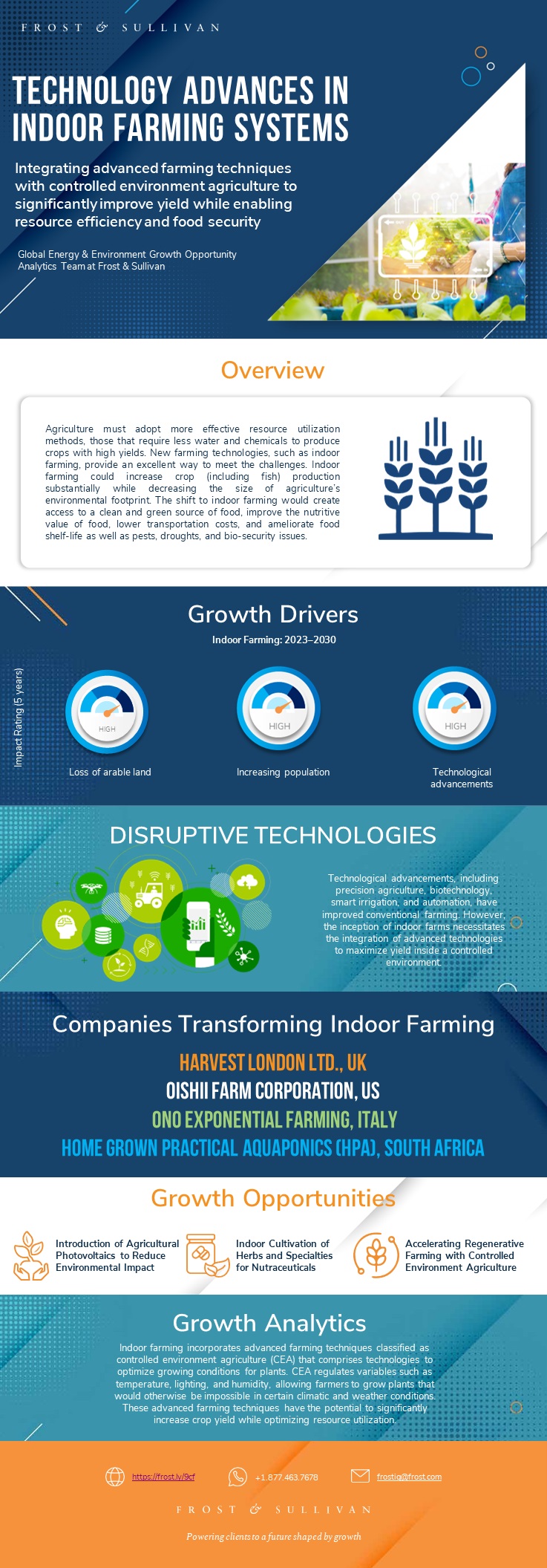Technology Advances in Indoor Farming Systems
Technology Advances in Indoor Farming Systems
Integrating Advanced Farming Techniques with Controlled Environment Agriculture to Significantly Improve Yield while Enabling Resource Efficiency and Food Security
31-Aug-2023
Global
Description
The world is experiencing unrelenting trends in population growth, decreasing water supply, urbanization, and climate change, all of which contributes to dwindling arable land stock. The United Nations (UN) Food and Agriculture Organization (FAO) estimates that the global population will reach 9.7 billion by 2050 and exceed 11 billion by 2100. To achieve food security, global food production will need to increase by up to 70% in the next 30 years. Today, unprecedented circumstances such as geopolitical tensions and pandemics are causing supply chain disruptions, limiting people's access to food in certain areas, particularly in countries that are already suffering from high levels of food insecurity.
Globally, the consensus is that agriculture must adopt more effective resource utilization methods, those that require less water and chemicals to produce crops with high yields. New farming technologies, such as indoor farming, provide an excellent way to meet these challenges. Indoor farming could increase crop (including fish) production substantially while decreasing the size of agriculture’s environmental footprint. The shift to indoor farming would create access to a clean and green source of food, improve the nutritive value of food, lower transportation costs, and ameliorate food shelf-life as well as pests, droughts, and bio-security issues. Indoor farming incorporates advanced farming techniques classified as controlled environment agriculture (CEA) that comprises technologies to optimize growing conditions for plants. CEA regulates variables such as temperature, lighting, and humidity, allowing farmers to grow plants that would otherwise be impossible in certain climatic and weather conditions. These advanced farming techniques have the potential to significantly increase crop yield while optimizing resource utilization.
This study on the technology advances in indoor farming systems covers the following research and analysis areas:
• Overview of indoor farming technologies, trends, and factors driving the development and adoption of various farming
systems
• Patent landscape and growth opportunities enabling the development and adoption of indoor farming
• Major stakeholders active in the indoor farming landscape
RESEARCH: INFOGRAPHIC
This infographic presents a brief overview of the research, and highlights the key topics discussed in it.Click image to view it in full size

Table of Contents
Why Is It Increasingly Difficult to Grow?The Strategic Imperative 8™: Factors Creating Pressure on Growth
The Strategic Imperative 8™
The Impact of the Top 3 Strategic Imperatives on the Indoor Farming Industry
Growth Opportunities Fuel the Growth Pipeline Engine™
Research Methodology
Key Factors Influencing Technological Advancements and Innovations in Modern Farming
Indoor Farming Solves Key Challenges Associated with Conventional Farming
Indoor Farming is Emerging as an Alternative to Traditional Farming and Is Reshaping the Future of Agriculture
Indoor Farming Growing Systems Are Incorporating Unique Features to Produce Crops in Controlled Environments
Indoor Farming Growing Systems Offer Growers Food Production Flexibility
Growth Drivers
Growth Restraints
Scope of Analysis
Segmentation
Improved Efficiency of CEA Is Gaining Popularity among Indoor Farmers
Indoor Farming Optimizes Water Usage for Operations in Any Environment
Bubbleponics Is Emerging as a New Growing System Preference among Farmers
The Development of Various Growing Media Helps Growers Choose the Right Type for Targeted Operations
North America and Europe are Making Notable Efforts to Advance Vertical Indoor Farming
Indoor Farming Adoption Trends Are Accelerating across Asia-Pacific and the Rest of the World
Coco Coir Is Becoming a Preferred Growing Medium among Indoor Farmers
Companies Are Innovating Unique Growing Media for Improved Yield
Advancement of LEDs Is Catalyzing the Development of Indoor Farming
Automation Will Make Indoor Farms Smarter
IoT’s Emergence Is Enhancing Connectivity in Indoor Farming Activities
The Growth of Indoor Farms Is Driving Businesses to Introduce Advanced Infrastructure Setups
Companies across Geographies Are Offering Contemporary Infrastructure Setups for Easy Installation and Effective Functioning
Automated Systems Are Incorporating Advanced Technologies for CEA
Aeroponics Growing Systems Are Finding Adoption among Indoor Growers
The Indoor Farming Ecosystem Is Seeing Various Partnerships and Collaborations across Geographies
Government Offices Are Allying with International Players to Address Local Food Requirements
Indoor Farming Is Leading to R&D Initiatives from Academic and Business Entities to Make It More Effective and Efficient
Government Investments, University Inventions, and Established Businesses Are Accelerating Indoor Farming
The Rise of Start-ups and More Investment in Sustainable and Local Food Production Are Contributing to Profitability and Recognition
Venture Capital Funding Is Emerging as the Most Preferred Investment Instrument toward Indoor Farming
Various Companies Are Transforming Indoor Farming to Address Local Food Requirements
Businesses Are Considering Indoor Farms to Produce Food in Urban Settings
United States Is Filing the Most Patents to Advance Indoor Farming Technologies
Businesses Are Actively Involved in Patent Activities to Establish the Uniqueness of their Indoor Farming Techniques
Growth Opportunity 1: Introduction of Agricultural Photovoltaics to Reduce Environmental Impact
Growth Opportunity 1: Introduction of Agricultural Photovoltaics to Reduce Environmental Impact (continued)
Growth Opportunity 2: Indoor Cultivation of Herbs and Specialties for Nutraceuticals
Growth Opportunity 2: Indoor Cultivation of Herbs and Specialties for Nutraceuticals (continued)
Growth Opportunity 3: Accelerating Regenerative Farming with CEA
Growth Opportunity 3: Accelerating Regenerative Farming with CEA (continued)
TRL: Explanation
Your Next Steps
Why Frost, Why Now?
Legal Disclaimer
Popular Topics
| Author | Abhishek Paul Choudhury |
|---|---|
| Industries | Environment |
| No Index | No |
| Is Prebook | No |
| Keyword 1 | Indoor Farming Market |
| Keyword 2 | Vertical Farming Market |
| Keyword 3 | Smart Indoor Farming Technology |
| Podcast | No |
| WIP Number | DAAF-01-00-00-00 |
 USD
USD GBP
GBP CNY
CNY EUR
EUR INR
INR JPY
JPY MYR
MYR ZAR
ZAR KRW
KRW THB
THB